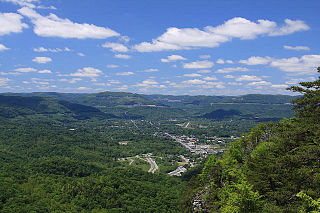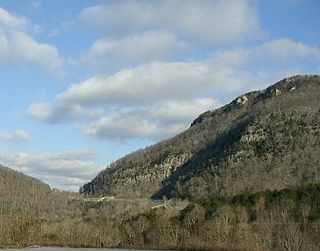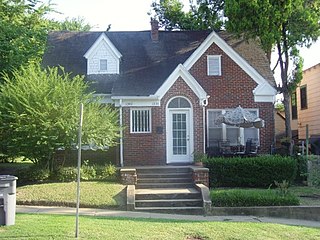
Bell County is a county located in the southeast part of the U.S. state of Kentucky. As of the 2020 census, the population was 24,097. Its county seat is Pineville. The county was formed in 1867, during the Reconstruction era from parts of Knox and Harlan counties and augmented from Knox County in 1872. The county is named for Joshua Fry Bell, a US Representative. It was originally called "Josh Bell", but on January 31, 1873, the Kentucky legislature shortened the name to "Bell",

Middlesboro is a home rule-class city in Bell County, Kentucky, United States. The population was 10,334 at the 2010 U.S. census, while its micropolitan area had a population of 69,060.

The Cumberland Gap National Historical Park is a United States National Historical Park located at the border between Kentucky, Tennessee, and Virginia, centered on the Cumberland Gap, a natural break in the Appalachian Mountains.

The Cumberland Gap is a pass through the long ridge of the Cumberland Mountains, within the Appalachian Mountains, near the junction of the U.S. states of Kentucky, Virginia, and Tennessee. It is famous in American colonial history for its role as a key passageway through the lower central Appalachians.

Bowman Field is a public airport five miles (8.0 km) southeast of downtown Louisville, in Jefferson County, Kentucky. The airport covers 426 acres (172 ha) and has two runways. The FAA calls it a reliever airport for nearby Louisville Muhammad Ali International Airport.

Abraham Lincoln Birthplace National Historical Park is a designated U.S. historic park preserving two separate farm sites in LaRue County, Kentucky, where Abraham Lincoln was born and lived early in his childhood. He was born at the Sinking Spring site south of Hodgenville and remained there until the family moved to the Knob Creek Farm northeast of Hodgenville when he was two years old, living there until he was seven years of age. The park's visitor center is located at the Sinking Spring site.

Swan Lake is a historic district in Tulsa, Oklahoma. Its borders consist of 15th Street to the North, Utica Street to the East, 21st Street to the South, and Peoria Avenue to the west. The District was developed in the early 20th century as a middle-class residential area with single-family homes, some duplexes and apartment buildings. It is still considered a highly regarded residential area with a high occupancy rate.

Blackacre State Nature Preserve is a 271-acre (110 ha) nature preserve and historic homestead in Louisville, Kentucky. The preserve features rolling fields, streams, forests, and a homestead dating back to the 18th century. For visitors, the preserve features several farm animals including horses, goats, and cows, hiking trails, and a visitor's center in the 1844-built Presley Tyler home. Since 1981, it has been used by the Jefferson County Public Schools as the site of a continuing environmental education program. About 10,000 students visit the outdoor classroom each year.

Wendover, also known as Frontier Nursing Service or Big House, is a historic house and former medical care facility near Hyden, Kentucky. Built in 1925, it is notable for its association with the American effort to professionalize midwifery, led by Mary Breckinridge (1881-1965). It was headquarters of the Frontier Nursing Service, an organization which continues today. Wendover was named a U.S. National Historic Landmark in 1991 for this role. It now serves as a bed and breakfast inn and retreat operated by the Service's success, Frontier Nursing University.

The Charles Young Buffalo Soldiers National Monument, a National Monument of the United States, commemorates the life of Charles Young (1864-1922), an escaped slave who rose to become a Buffalo Soldier in the United States Army and its first African-American colonel. It is located on United States Route 42 in Wilberforce, Ohio, in a house purchased by Young in 1907 that was designated a National Historic Landmark in 1974. The monument is administered by the National Park Service; the house is open by appointment for tours.

Schenectady City Hall is the seat of government of the city of Schenectady, New York, United States. Designed by McKim, Mead, and White, the building was constructed between 1931 and 1933. It is located on the block between Clinton, Franklin, Jay and Liberty streets. It is built in a revival of the Federal Style, the dominant style of American architecture from 1780 to 1830. Its most prominent features include the square clock tower, with its gold-leaf dome and weathervane, and the Ionic neoclassical portico. It houses not only city government but the local office of U.S. Rep. Paul Tonko.
Mt. Moriah Baptist Church is a historic church at 314 N. Main Street in Middlesboro, Kentucky. It was built during 1918-21 and added to the National Register of Historic Places in 1985.
The St. Mary's Episcopal Church in Middlesboro, Kentucky is a historic church located at 131 Edgewood Road. It was built in 1880 and opened for services in February 1881. It was added to the National Register of Historic Places in 1984.
Cane Springs Primitive Baptist Church is a historic Primitive Baptist church in College Hill, Kentucky. It was built in c.1812-1813 and added to the National Register of Historic Places in 1978.

The Frank Pierce Carpenter House is a historic house at 1800 Elm Street on the north side of Manchester, New Hampshire. Built in 1891 for the president of the Amoskeag Paper Company, it is a fine local example of high-style Queen Anne architecture. It was listed on the National Register of Historic Places in 1994, and was home to the local chapter of the American Red Cross for approximately 71 years from the start of WWII.

Simons' Inn, also known more recently as Rowell's Inn, is a historic traveler's accommodation on Vermont Route 11 in Andover, Vermont. Built in 1826, it is a remarkably well-preserved example of a 19th-century stagecoach inn. It has for many years been a local community meeting point, serving as a general store and post office until 1950. It was listed on the National Register of Historic Places in 1979. It is now a private residence.
Dr. Clyde Carroll House, on Dead Man's Cave Rd. in White Mills, Kentucky is a historic house built in 1903. It was listed on the National Register of Historic Places in 1988.

The Middlesboro Downtown Commercial District in Middlesboro, Kentucky is a 37 acres (15 ha) historic district which was listed on the National Register of Historic Places in 1983.

The Hotel on Phillips is a hotel at 100 N. Phillips Ave. in Sioux Falls, South Dakota. It is located in the former Sioux Falls National Bank building, a skyscraper built in 1917, during World War I. The building was listed on the National Register of Historic Places in 1979 as "Sioux Falls National Bank Building". The property has also been known as the 100 North Phillips Building.

The John Parker Tavern is a historic building located at 2 Morristown Road in the borough of Bernardsville in Somerset County, New Jersey. Originally known as the Vealtown Tavern, it was frequently used by Continental Army soldiers during the American Revolutionary War. It was added to the National Register of Historic Places on December 14, 1978 for its significance in commerce, military history, and local history.
















